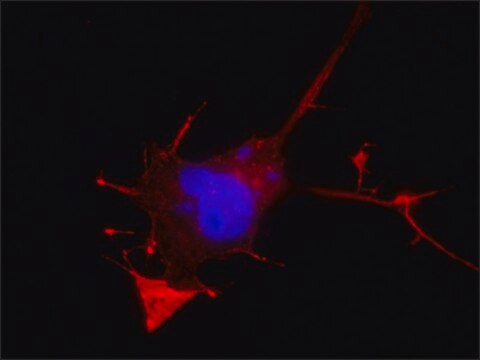推薦產品
生物源
mouse
共軛
unconjugated
抗體表格
purified immunoglobulin
抗體產品種類
primary antibodies
無性繁殖
3E5, monoclonal
形狀
buffered aqueous solution
分子量
antigen ~37.11 kDa
物種活性
human
技術
indirect ELISA: suitable
western blot: 1-5 μg/mL
同型
IgG2aκ
NCBI登錄號
UniProt登錄號
運輸包裝
dry ice
儲存溫度
−20°C
目標翻譯後修改
unmodified
基因資訊
human ... UBE3A(7337)
一般說明
This gene encodes an E3 ubiquitin-protein ligase, part of the ubiquitin protein degradation system. This imprinted gene is maternally expressed in brain and biallelically expressed in other tissues. Maternally inherited deletion of this gene causes Angelman Syndrome, characterized by severe motor and intellectual retardation, ataxia, hypotonia, epilepsy, absence of speech, and characteristic facies. The protein also interacts with the E6 protein of human papillomavirus types 16 and 18, resulting in ubiquitination and proteolysis of tumor protein p53. Alternative splicing of this gene results in three transcript variants encoding three isoforms with different N-termini. Additional transcript variants have been described, but their full length nature has not been determined. (provided by RefSeq)
免疫原
UBE3A (AAH09271, 51 a.a. ~ 150 a.a) partial recombinant protein with GST tag. MW of the GST tag alone is 26 KDa.
Sequence
ETFQQLITYKVISNEFNSRNLVNDDDAIVAASKCLKMVYYANVVGGEVDTNHNEEDDEEPIPESSELTLQELLGEERRNKKGPRVDPLETELGVKTLDCR
Sequence
ETFQQLITYKVISNEFNSRNLVNDDDAIVAASKCLKMVYYANVVGGEVDTNHNEEDDEEPIPESSELTLQELLGEERRNKKGPRVDPLETELGVKTLDCR
應用
Applications in which this antibody has been used successfully, and the associated peer-reviewed papers, are given below.
Immunofluorescence (1 paper)
Immunohistochemistry (1 paper)
Immunofluorescence (1 paper)
Immunohistochemistry (1 paper)
外觀
Solution in phosphate buffered saline, pH 7.4
免責聲明
Unless otherwise stated in our catalog or other company documentation accompanying the product(s), our products are intended for research use only and are not to be used for any other purpose, which includes but is not limited to, unauthorized commercial uses, in vitro diagnostic uses, ex vivo or in vivo therapeutic uses or any type of consumption or application to humans or animals.
未找到適合的產品?
試用我們的產品選擇工具.
儲存類別代碼
12 - Non Combustible Liquids
水污染物質分類(WGK)
WGK 1
閃點(°F)
Not applicable
閃點(°C)
Not applicable
分析證明 (COA)
輸入產品批次/批號來搜索 分析證明 (COA)。在產品’s標籤上找到批次和批號,寫有 ‘Lot’或‘Batch’.。
Alain C Burette et al.
The Journal of comparative neurology, 525(2), 233-251 (2016-06-25)
Ubiquitination regulates a broad array of cellular processes, and defective ubiquitination is implicated in several neurological disorders. Loss of the E3 ubiquitin-protein ligase UBE3A causes Angelman syndrome. Despite its clinical importance, the normal role of UBE3A in neurons is still
Janet Berrios et al.
Nature communications, 7, 10702-10702 (2016-02-13)
Motivated reward-seeking behaviours are governed by dopaminergic ventral tegmental area projections to the nucleus accumbens. In addition to dopamine, these mesoaccumbal terminals co-release other neurotransmitters including glutamate and GABA, whose roles in regulating motivated behaviours are currently being investigated. Here
Carissa L Sirois et al.
Human molecular genetics, 29(18), 3021-3031 (2020-08-25)
Loss of UBE3A expression, a gene regulated by genomic imprinting, causes Angelman syndrome (AS), a rare neurodevelopmental disorder. The UBE3A gene encodes an E3 ubiquitin ligase with three known protein isoforms in humans. Studies in mouse suggest that the human
Michael S Sidorov et al.
The Journal of neuroscience : the official journal of the Society for Neuroscience, 38(11), 2671-2682 (2018-02-13)
Angelman syndrome (AS), a neurodevelopmental disorder associated with intellectual disability, is caused by loss of maternal allele expression of UBE3A in neurons. Mouse models of AS faithfully recapitulate disease phenotypes across multiple domains, including behavior. Yet in AS, there has
Eric S McCoy et al.
The Journal of neuroscience : the official journal of the Society for Neuroscience, 37(42), 10230-10239 (2017-09-22)
Angelman syndrome (AS) is a severe neurodevelopmental disorder caused by mutation or deletion of the maternal UBE3A allele. The maternal UBE3A allele is expressed in nearly all neurons of the brain and spinal cord, whereas the paternal UBE3A allele is
我們的科學家團隊在所有研究領域都有豐富的經驗,包括生命科學、材料科學、化學合成、色譜、分析等.
聯絡技術服務







